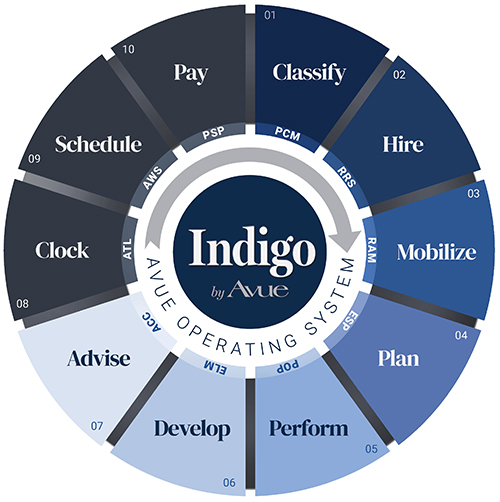
Indigo by Avue sits on a platform built on certain core principles of federal human capital management:
- is integral to mission success in any organization;
- involves a seamless web of different disciplines, decisions, actions, and processes;
- requires solutions that are correspondingly seamless and that support effective collaboration by management, supervisors and HR professionals;
- requires support from an optimal combination of human expertise and judgment together with state-of-the-art continuous innovation technology platform providing:
- transactional automation,
- expert system capabilities for decision support and compliance,
- data, information, and display for senior management insight
These principles result in Avue being a business operations platform that uses a highly correlated database and expert system rules engines to ensure built-in statutory and regulatory compliance while automating 80-90 percent of the entire end-to-end process for all participants. Avue also addresses the remaining 10-20 percent of the process by increasing the efficiency and effectiveness of the process.
But these principles would not be complete without these additional signature elements found only in Avue:
- Compliance: Indigo by Avue is a native federal platform specifically designed to ensure its federal agency customers are compliant with federal regulations, including classification, the Uniform Guidelines on Employee Selection Procedures, the Merit System, veterans’ preference, delegated examining, and all hiring regulations including direct hire.
- Artificial Intelligence and RPA for Better, Faster, Cheaper HR Operations: Avue uses artificial intelligence (AI) and robotic process automation (RPA) to increase the accuracy and speed of human resource transactions. HR functions that are buried under a high volume of procedural regulations are performed with greater accuracy and more efficiently than applying human labor to the task. Areas like applicant eligibilities screening, Nature of Action Code determination and the processing of personnel actions, creation of delegated examining files for audit purposes, SF-52 and SF-40 population, accreditation checks of higher education institutions, validation of application completeness, posting to thousands of recruitment sites, and pay setting are just some of the areas where AI makes a great difference in reducing labor hours, increasing accuracy, substantially cutting cycle time, and improving the servicing ratio of HR operations. Downstream functions, like payroll, are affected by errors upstream in pay setting or NOAC determination that burn labor due to rework. AI addresses these functions in a manner that is, literally, better than human.
- Artificial Intelligence to Overcome HR Skill Decay: Certain deep HR skills, like job classification and job analysis have gradually decayed and disappeared over the decades. Augmenting such skill deficits with contractors doesn’t mean the gap closes. HR practitioners with good skills and, that are expert enough to be efficient, are moving on. This is another area where Avue AI, once again, can take the place of human labor. Even areas that appear to require highly refined judgment — like job classification and job analysis — are made better, faster, and cheaper with AI.
- Business Process Optimization: Avue’s business process management and workflow utilizes a human-in-the-loop (HITL) process that perfects machine learning by generating analytics and reports, including cycle time analytics, that inform business process innovation and labor optimization. Avue’s workflow constructs, over time, the real business process by tracking and reporting on process steps, user roles, conformance, deviations (skipping steps or inserting steps), and cycle time by step and user role. The workflow also ensures that ‘soft guard rails’ keep users, regardless of role, compliant with regulation, and at the same time, allows for deviations which are tracked and reported. These analytics inform the HITL process of examining policies, procedural requirements, regulations, and external factors to optimize HR operational performance. Avue workflow includes parallel process steps so artificial backlogs are avoided and a truer picture of the cycle time and labor effort burn can be identified.
- Dashboards, Predictive Analytics, and Data Reliability: Avue consumes and makes available considerable data about HR operations, labor costs, the workforce (skills, competencies, credentials, retirement eligibility, etc.), mission/operations costs, pay (overtime, compensatory time, vacancy lapse rates, etc.), employee development needs, performance outcomes, and other related data. Avue APIs provide the means of ingesting and exporting data from other systems and sources, including labor market data, pay comparability data, operations data, and payroll data. Avue’s nightly sync with National Finance Center data helps ensure data reliability. Avue analytics take that data and provide analysis, insight, and predictive capabilities that can be access by managers and staff for decision support.
- The World’s Only Correlated Federal Occupational Database: Avue’s SaaS model includes the ability to deploy within hours of contract award. Having a native federal and compliant system, with a responsive design and great UX, makes that possible — but having the access to the massive federal occupational database and embedded AI make Avue Indigo a rapid and friction-free deployment — in hours for initial users and within 30 days for broad deployment. The occupational content is engineered down to the task level using an Avue patented data correlation and content publishing methodology and application. The process complies with Uniform Guidelines on Employee Selection Procedures, Merit System principles, prevailing OPM practices, and content validity standards. Avue’s staff has thousands of years of experience in federal human resources, classification, job analysis, staffing, delegated examining, and employee relations. This deep expertise is applied to the content engineering process. Each task is correlated to skills, competencies, certifications, credentials, training courses, developmental activities, performance metrics, FLSA exemption determination, grades, titles, federal occupational series, interview questions, reference check questions, private sector comparable titles, comparable military MOS, cybersecurity codes (NICE framework), skills survey questions, crediting plans, job analysis, and applicant online assessment questions.